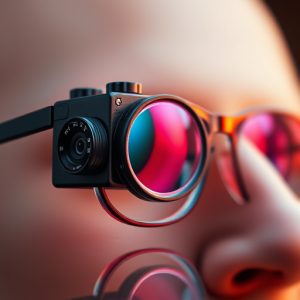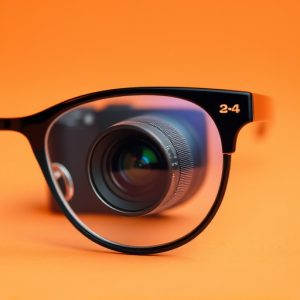Through the Lens: Exploring the Impact and Future of Glasses with Built-in Cameras
Camera-equipped glasses have revolutionized wearable technology, offering advanced imaging and augme…….
Camera-equipped glasses have revolutionized wearable technology, offering advanced imaging and augmented reality capabilities that have transitioned from specialized uses to mainstream consumer products. These devices feature high-resolution cameras on par with digital cameras and smartphones, enabling users to capture detailed images and videos with wide-angle lenses and sophisticated image processing software. They support various resolutions including Full HD and 4K, and include motion stabilization through gyroscopes, accelerometers, and image stabilization systems. Connectivity features allow for easy sharing via Wi-Fi and Bluetooth, and voice control enhances their versatility for both personal enjoyment and professional applications. As these glasses become more stylish and functional, they also raise significant privacy and ethical concerns, necessitating clear guidelines and responsible design to ensure compliance with regulations and respect for individual rights. The potential of these glasses extends into various fields, including education, healthcare, and entertainment, promising to fundamentally transform daily interactions through augmented reality and artificial intelligence. As society navigates the integration of these devices, they are set to become a seamless part of our lives, offering new ways to interact with the world and each other.
Exploring the intersection of technology and everyday life, this article delves into the multifaceted world of glasses equipped with built-in cameras. From their emergence as a wearable innovation to their potential future trajectory, we examine the myriad ways these devices are transforming our visual and recording capabilities. We will dissect the technical specifications that define their functionality, explore their practical applications across various domains, address privacy and ethical concerns, and predict how glasses with a camera built in will continue to evolve and influence society. Join us as we focus on the lens through which this technology shapes our interactions with the world around us.
The Evolution of Wearable Cameras: A Glimpse into Glasses with Built-in Cameras
The integration of cameras into eyewear has marked a significant advancement in the realm of wearable technology, with glasses with a camera built in standing at the forefront of this evolution. Initially conceptualized as a niche application for professionals requiring hands-free recording capabilities, such as surgeons or engineers, these devices have rapidly expanded into mainstream consumer products. The early iterations of wearable cameras, like Google Glass, paved the way for this technology by introducing augmented reality features and hands-free photography and videography. Since then, the functionality and design of glasses with a camera built in have evolved, offering users enhanced experiences through features such as real-time image and video capture, voice commands, and seamless connectivity to smartphones and other devices.
Today, glasses with a camera built in are more sophisticated than ever before, boasting high-resolution imaging, longer battery life, and advanced software algorithms that enable smart functionalities like facial recognition, language translation, and augmented reality overlays. The ongoing development of these devices is driven by the fusion of miniaturized electronics and AI, which not only enhances their capabilities but also makes them more user-friendly and accessible to a broader audience. As privacy concerns and societal norms evolve alongside the technology, glasses with a camera built in continue to navigate the delicate balance between innovation and ethical use, promising to redefine our interactions with both the digital world and the physical spaces we inhabit.
Technical Specifications: Understanding the Capabilities of Camera-equipped Glasses
When exploring the realm of camera-equipped glasses, delving into the technical specifications is paramount for grasping their capabilities. These advanced devices often incorporate high-resolution cameras that mimic the functionality of standalone digital cameras or smartphones. Users can capture crisp, detailed images and videos with the same clarity as these devices, thanks to the sophisticated imaging sensors housed within the glasses. The lenses are designed with wide-angle views, enabling users to frame their shots effectively, while built-in software algorithms assist in adjusting exposure levels and focus for optimal results.
In terms of image capture, these glasses typically offer a range of resolution options, from Full HD to 4K, catering to both casual users and professionals who require high-quality visuals. The integration of gyroscopes and accelerometers allows for smooth video recording, effectively counteracting hand tremors or movement. Additionally, many camera-equipped glasses are equipped with advanced image stabilization systems that ensure clear and steady footage, even when on the move. Furthermore, they often come with internal storage or offer real-time streaming capabilities via Wi-Fi or Bluetooth connectivity to smartphones or tablets, facilitating easy sharing of captured content. With features such as voice control and app integration, these glasses represent a convergence of fashion and functionality, making them versatile tools for both personal use and professional applications.
Practical Applications: How Everyday Individuals Use Glasses with a Camera Built In
Everyday individuals are increasingly adopting glasses equipped with cameras as a versatile tool for capturing life’s moments. These smart glasses offer a seamless integration of photography and augmented reality into daily activities, providing users with a hands-free way to record and interact with their environment. For instance, professionals who require both hands for their work, such as technicians or surgeons, benefit from being able to document processes or take notes without interruption. Similarly, educators can record lectures or demonstrations, ensuring that key information is preserved for later review by students. Recreational users appreciate the ability to capture spontaneous photos and videos, whether they’re engaged in sports, spending time with family, or exploring new destinations. The cameras embedded within these glasses also facilitate video chatting with a more natural field of view, as if face-to-face with the other person, enhancing the quality of virtual interactions. Moreover, the integration of camera-equipped glasses into everyday life is paving the way for new experiences in gaming, where players can have a more immersive and interactive experience by capturing their physical environment to complement digital gameplay. As these devices become more advanced, their applications continue to expand, offering users a multitude of practical ways to integrate visual recording into their daily lives with ease and discretion.
Privacy and Ethics: Navigating the Concerns Surrounding Wearable Camera Technology
Glasses equipped with cameras have become increasingly sophisticated, blending seamlessly into everyday wearables. As these devices become more common, they raise significant concerns regarding privacy and ethics. Users must be cognizant of when and where they record, as unauthorized recording can violate privacy laws and personal boundaries. The ethical implications are manifold; from consent in public spaces to the potential for surveillance without individuals’ knowledge or consent. It’s crucial for manufacturers to incorporate clear indicator lights and ensure users understand the legal and moral framework governing video capture in different jurisdictions. Moreover, the retention and protection of recorded data must be a priority, with robust policies that safeguard against unauthorized access and misuse. As these wearable cameras become more integrated into our lives, an ongoing dialogue between tech developers, policymakers, and users is essential to navigate the evolving landscape of privacy and ethics in this realm.
Future Trends: Predicting the Role of Glasses with Cameras in Tomorrow's World
As technology continues to advance, glasses with a camera built in are poised to become increasingly sophisticated and ubiquitous in tomorrow’s world. These devices are already on the cusp of revolutionizing how we interact with our surroundings, providing augmented reality (AR) capabilities that can enhance daily tasks from navigation to real-time translation. In the near future, we can anticipate these glasses will offer even more seamless integration with digital environments, potentially transforming education, healthcare, and entertainment sectors. For instance, students may use AR glasses for interactive learning experiences, while medical professionals could access critical patient data during procedures without the need to glance away from the patient. Furthermore, the entertainment industry is likely to leverage these devices to create immersive experiences that blend the physical and virtual worlds.
The potential applications of glasses with a camera built in extend beyond current imaginings. As machine learning algorithms improve and data privacy standards evolve, these devices could offer personalized recommendations, provide real-time safety alerts, or even assist visually impaired individuals by describing their surroundings through advanced image recognition technology. The convergence of AR and artificial intelligence (AI) within these glasses is expected to open up a myriad of possibilities, from enhancing human cognition to connecting people in new ways. As society embraces this wearable tech, the role of glasses with a camera built in will likely expand, subtly yet significantly altering the fabric of daily life and offering a window into the interconnected future of computing and perception.


